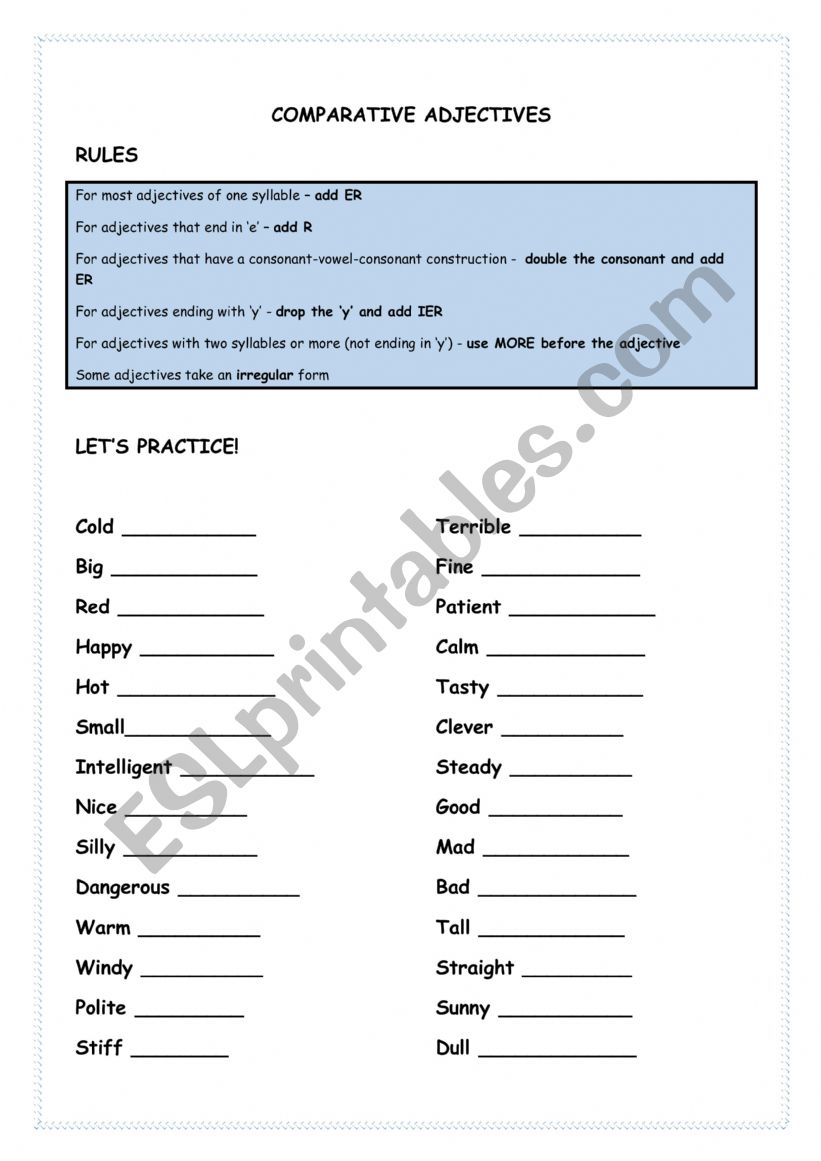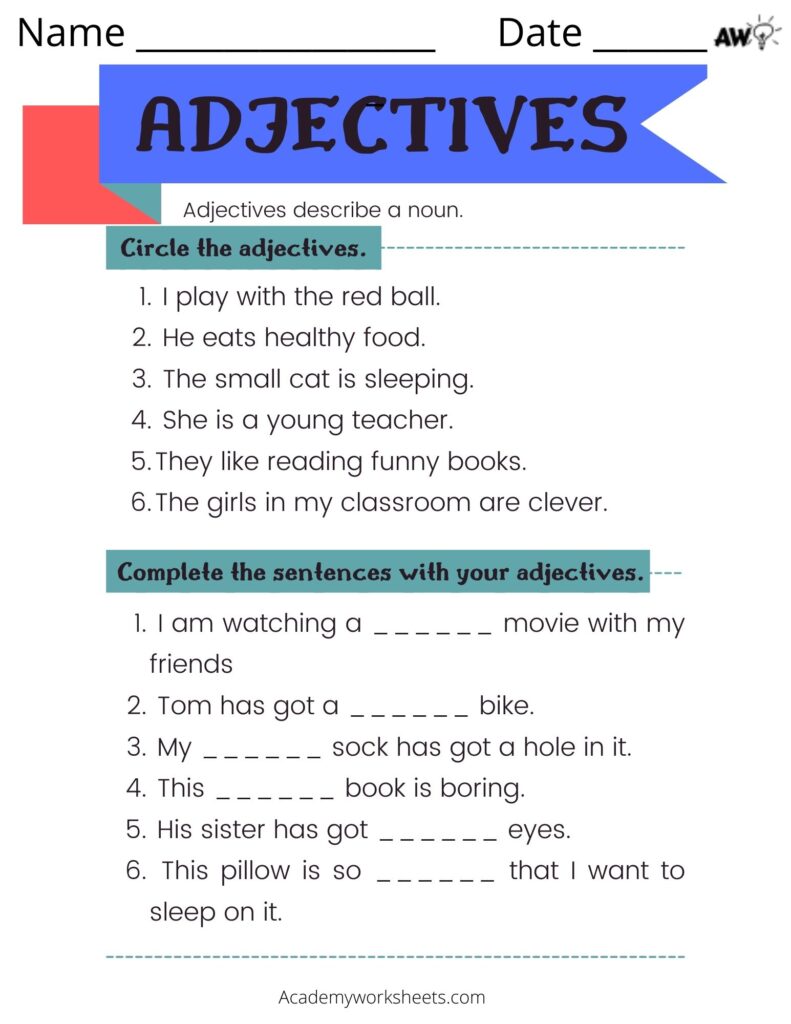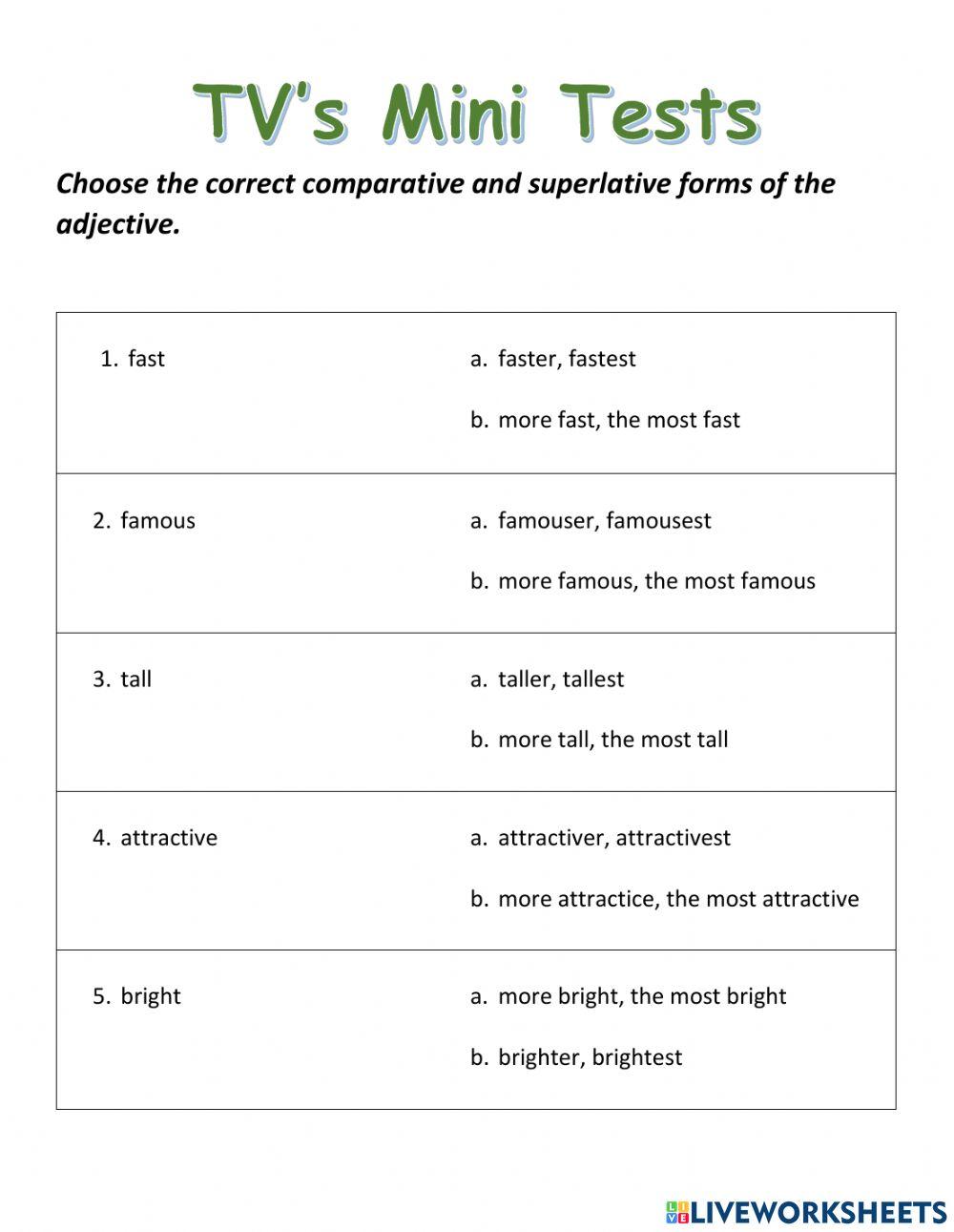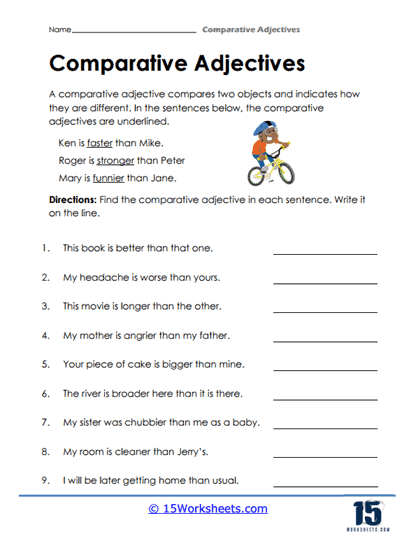
Mastering Comparison: The Essential Role of the More and Most Adjectives Worksheet
In the intricate tapestry of the English language, adjectives play a crucial role in adding color, detail, and precision to our descriptions. They allow us to paint vivid pictures, convey specific emotions, and differentiate between similar things. However, merely using adjectives isn’t enough; to express nuances of comparison, we rely on their comparative and superlative forms. This is where "more" and "most" come into play, serving as indispensable tools for adjectives that don’t follow the regular "-er" and "-est" patterns. For learners grappling with these distinctions, a well-structured more and most adjectives worksheet becomes an invaluable resource, providing the targeted practice necessary for mastery.
The Foundation: Understanding Comparative and Superlative Adjectives
Before diving into the specifics of "more" and "most," it’s vital to grasp the broader concept of comparative and superlative adjectives.

- Comparative Adjectives: These are used when comparing two things, people, or ideas. They indicate which of the two has more of a certain quality. For example, "This car is faster than that one." or "She is taller than her brother."
- Superlative Adjectives: These are used when comparing three or more things, people, or ideas. They indicate which one has the most of a certain quality among the group. For example, "He is the fastest runner on the team." or "That is the tallest building in the city."


The formation of comparative and superlative adjectives largely depends on the number of syllables in the adjective:
-
One-syllable adjectives: Typically add "-er" for the comparative and "-est" for the superlative.
- Old: Older, Oldest
- Big: Bigger, Biggest (note the doubling of the consonant)
- Nice: Nicer, Nicest (if ending in ‘e’, just add ‘r’ or ‘st’)



-

Two-syllable adjectives ending in -y: Change the ‘y’ to ‘i’ and add "-er" or "-est."
- Happy: Happier, Happiest
- Easy: Easier, Easiest
-
Irregular adjectives: Some common adjectives have completely different forms.
- Good: Better, Best
- Bad: Worse, Worst
- Far: Farther/Further, Farthest/Furthest
The Indispensable Role of "More" and "Most"
This brings us to the core focus: adjectives that don’t fit the "-er" or "-est" rules, primarily those with two or more syllables (and not ending in -y). For these adjectives, we use "more" for the comparative and "most" for the superlative.
-
Using "More" (Comparative): When comparing two items with longer adjectives, we place "more" before the adjective.
- Beautiful: This painting is more beautiful than that one.
- Expensive: My new phone was more expensive than my old one.
- Difficult: This puzzle is more difficult than the last one.
-
Using "Most" (Superlative): When comparing three or more items with longer adjectives, we place "most" before the adjective, usually preceded by "the."
- Beautiful: She is the most beautiful person I know.
- Expensive: That is the most expensive car in the showroom.
- Difficult: This was the most difficult exam of my life.
Understanding when to use "more" and "most" versus "-er" and "-est" is a common stumbling block for English learners. It requires not just memorization but also an intuitive grasp of syllable count and common usage. This is precisely why a dedicated more and most adjectives worksheet is so crucial.
Why Worksheets Are Essential for Mastering "More" and "Most"
Learning grammar concepts is one thing; internalizing them for fluent and accurate use is another. This is where practice, repetition, and immediate feedback come into play, and why worksheets are so effective.
- Reinforcement: Worksheets provide structured opportunities to apply newly learned rules. By repeatedly identifying the correct form, learners solidify their understanding.
- Identification of Weak Spots: As learners complete a more and most adjectives worksheet, they quickly discover which types of adjectives or which specific rules they struggle with. This allows them or their instructors to target areas needing more attention.
- Structured Practice: Unlike free-form speaking or writing, a worksheet guides the learner through specific exercises, ensuring they focus on the particular grammatical structure being taught.
- Independent Learning: Worksheets enable learners to practice at their own pace, outside of a classroom setting. With an answer key, they can even self-assess their progress.
- Building Confidence: Successfully completing exercises builds confidence, encouraging learners to use these forms more readily in their speaking and writing.
What Makes an Effective More and Most Adjectives Worksheet?
Not all worksheets are created equal. An effective more and most adjectives worksheet should possess several key characteristics to maximize its learning potential:
-
Variety of Exercises:
- Fill-in-the-blanks: Simple sentences where learners choose between "more" or "most" and the base adjective, or the correct comparative/superlative form.
- Sentence Completion: Providing a base adjective and asking learners to complete a sentence using its correct comparative or superlative form (e.g., "The blue car is __ (fast) than the red one." or "She is __ (intelligent) student in the class.").
- Error Correction: Presenting sentences with incorrect comparative/superlative forms and asking learners to identify and correct them (e.g., "This book is more better than that one.").
- Sentence Transformation: Asking learners to rewrite sentences using comparative or superlative forms (e.g., "No other student is as tall as John." -> "John is the tallest student.").
- Creating Sentences: Providing a list of adjectives and asking learners to create their own comparative and superlative sentences using them.
- Multiple Choice: A quick way to test recognition of correct forms.
-
Clear Instructions: Ambiguous instructions can lead to frustration and incorrect practice. Instructions should be concise and easy to understand.
-
Gradual Difficulty: A good worksheet might start with simpler, shorter adjectives and progress to more complex, multi-syllabic ones, eventually incorporating irregular forms.
-
Contextualized Sentences: Using sentences that are relevant, engaging, or tell a mini-story can make the practice more meaningful and less dry. Avoid isolated, meaningless phrases.
-
Inclusion of Both "More/Most" and "-er/-est" Forms: While the focus is on "more" and "most," a truly comprehensive worksheet will also include adjectives that use "-er" and "-est," forcing learners to discriminate between the two rules. This reinforces the broader concept of comparative and superlative adjectives.
-
Answer Key: Essential for self-correction and independent learning. It allows learners to immediately verify their answers and understand where they went wrong.
-
Engaging Content/Design: While not strictly grammatical, a well-designed worksheet with clear layout, perhaps some relevant illustrations, can make the learning experience more enjoyable.
Designing Your Own or Choosing the Best More and Most Adjectives Worksheet
For educators and parents, creating or selecting the right worksheet is key.
- Assess Learner Level: Tailor the worksheet to the learner’s proficiency. Beginners might need more basic fill-in-the-blank exercises, while advanced learners can benefit from error correction and sentence creation.
- Focus on Common Adjectives: Start with adjectives commonly used in everyday conversation (e.g., beautiful, important, difficult, interesting, exciting, comfortable).
- Integrate Irregulars: Don’t shy away from irregular adjectives like good/better/best or bad/worse/worst, as they are frequently used and often cause confusion.
- Online Resources: Many educational websites offer free printable worksheets. Look for reputable sources like British Council, ESL websites, or educational publishers. Many sites specifically offer a more and most adjectives worksheet tailored for different levels.
Common Pitfalls and How Worksheets Can Help Overcome Them
Learners often make specific mistakes when using comparative and superlative adjectives, particularly with "more" and "most." A well-designed worksheet can target these common errors:
- Double Comparatives/Superlatives: Using "more" or "most" with an adjective that already has an "-er" or "-est" ending (e.g., "more better," "most fastest"). Worksheets can have specific error correction exercises to highlight this redundancy.
- Mixing Rules: Applying "-er/-est" to longer adjectives or "more/most" to one-syllable adjectives (e.g., "difficult-er," "more big"). Exercises that require learners to choose the correct formation based on syllable count are vital.
- Incorrect Usage of "Than" and "The": Forgetting "than" after a comparative adjective or "the" before a superlative adjective (e.g., "She is taller I am," "He is most intelligent student"). Worksheets can provide sentence frames where these words are either missing or need to be inserted correctly.
- Misidentifying Irregulars: Treating irregular adjectives as regular (e.g., "gooder," "badest"). Dedicated sections or repetitive drills for irregular forms are beneficial.
By systematically addressing these common errors through varied and targeted exercises, a more and most adjectives worksheet helps learners develop an intuitive understanding and avoid these pitfalls in their own communication.
Beyond the Worksheet: Applying the Knowledge
While the more and most adjectives worksheet is an excellent tool for foundational learning and practice, it’s crucial to remember that its ultimate purpose is to facilitate real-world communication. Once learners have a grasp of the concepts, they should be encouraged to:
- Speak: Engage in activities that require comparison, such as describing differences between two pictures, comparing family members, or discussing preferences.
- Write: Encourage descriptive writing that incorporates comparative and superlative adjectives. Ask them to write reviews, compare products, or describe a "best day ever."
- Read: Point out examples of comparative and superlative adjectives in texts. Analyzing how native speakers use them in context reinforces learning.
- Listen: Pay attention to how these forms are used in movies, songs, and everyday conversations.
In conclusion, the ability to correctly use comparative and superlative adjectives, particularly those requiring "more" and "most," is fundamental for effective and nuanced English communication. It allows speakers and writers to express precise comparisons and distinguish between qualities with clarity. For learners, the journey to mastering these forms is significantly aided by consistent, targeted practice. A well-designed, comprehensive more and most adjectives worksheet serves as an indispensable tool in this journey, providing the structured exercises and reinforcement necessary to transform grammatical rules into confident and accurate language use. It’s not just about filling in blanks; it’s about building the linguistic muscle memory required for fluent and expressive English.
